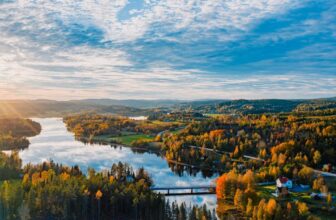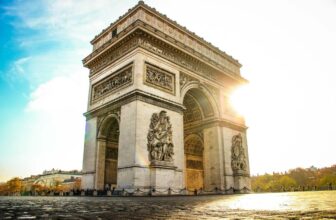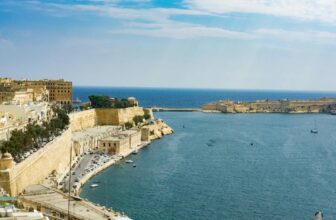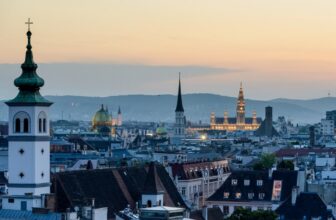Best Time to Visit Norway for Northern Lights | A Quick Guide
A significant appeal of visiting Norway is the opportunity to view the Northern Lights. However, it’s not always a given that you’ll catch a glimpse of this unpredictable phenomenon.
The timing of your trip is essential in determining your chances of having this once-in-a-lifetime experience. Thankfully, there are several steps you can take to ensure you get the most out of your trip. Keep reading to discover the what, when, and where of Norway’s Northern Lights.
Quick Tip: Check out this guide for information and expert tips on the best time to visit Norway.
Northern Lights: Basic Information
The Northern Lights are a naturally occurring exhibition of colorful lights in the night sky. The more scientific name for this spectacle is aurora borealis.
“Aurora” refers to the light display, while “borealis” identifies it as occurring in the Northern hemisphere. It’s important to make this distinction because the aurora can also occur in the Southern hemisphere.
What Causes The Northern Lights?
An aurora is the result of interactions between solar wind and the Earth’s atmosphere. Solar wind consists of ions from the sun that speed toward our planet. Some of these ions enter the Earth’s atmosphere at the magnetic Northern and Southern poles. They collide with atmospheric atoms and create a burst of energy that we see in the form of a colorful aurora.
Where to See The Northern Lights
Auroras only occur near the Earth’s North and South poles in the Arctic and Antarctic circles. The Earth’s extreme Northern region has much more land mass than the South. This makes the Northern Lights easier and more convenient to view than their Southern counterparts.
Countries that extend into the topmost part of the Northern hemisphere include Greenland, Iceland, Canada, Finland, Sweden, and Norway. These are all great places to see the Northern Lights. However, Norway stands out from the rest… Read on to find out why.
The Northern Lights in Norway
Norway is part of the Scandinavian region of Northern Europe. With majestic mountains and fjords (oceanic valleys), the country is a picture-perfect destination. It’s also one of the most popular places to see the Northern Lights.
This is partially due to its centrality and multiple hubs, which make it easy for foreigners to visit. Once you’re in Norway, getting around the country is also very simple. So, not only can you view the Northern Lights, but you can also explore your exciting surroundings. This ease of travel makes for a fun-filled trip from start to finish.
Best Time to See Northern Lights in Norway
Now that you know you’re bound to have a great time, it’s time to start planning. You’re probably wondering when to see the Northern Lights in Norway. It can be tough to figure out the best time because the aurora borealis occur year-round. Don’t worry, though — below is everything you need to know to organize the perfect trip.
A key element to viewing the Northern Lights is darkness. The northern region of Norway has minimal to no sunlight during the winter (December to February). This makes these months an ideal viewing time. However, there is some leeway on either side of this timeframe, so anytime between October and March is good.
Another essential factor to consider is viewing clarity. Clear skies are a must when it comes to seeing the Northern Lights in all their glory. However, this is tricky to predict — especially since Winter is usually a time of rain and snowfall.
Unpredictability is also a characteristic of the Northern Lights themselves. There’s no schedule telling you exactly when they will appear. Instead, you have to keep your fingers crossed and wait.
There’s nothing worse than making your trip too short and missing out on the Northern Lights. Statistically, it’s wise to play it safe and book a slightly longer trip (usually around a week). That way, you’ll secure your chances of experiencing the awe-inspiring aurora borealis in Norway.
Quick Tip: Once in Norway, you should download the NorwayLights app. This nifty app provides 3-day forecasts of the best times of day to see the Northern Lights.
Planning Your Trip to Norway
While at night you’ll be staring skywards, there are numerous other activities to keep you occupied during the day. Norway is home to a multitude of tourist attractions that you can include in your Northern Lights vacation.
Outdoor enthusiasts can explore Norway’s landscape with a variety of winter activities. Popular options include skiing on the snowy mountaintops or, for the more endurance-oriented, doing the famous Besseggen Ridge hike, as it’s one of the best hikes in Europe. For a one-of-a-kind transport experience, you can even try some local dog sledding.
If you love art or history, then you should definitely check out some of the country’s world-famous museums. At the Munch Museum, you can learn about the artist behind the famous expressionist painting, The Scream. If you’re looking for a more unusual museum experience, try visiting the mind-boggling Paradox Museum.
Packing for Norway’s Northern Lights
Viewing the Northern Lights involves spending the night outdoors, so it’s important to pack clothing that will accommodate this. Norway usually has a relatively temperate climate. However, the winter months can get very cold, especially in the north. The average temperature of a Norwegian winter is 19.76° Fahrenheit (-6.8° Celsius).
Clothing
The cold weather can be a shock to your system, especially if you’re visiting from a warmer climate. It’s essential to pack lots of winter clothing to keep yourself nice and toasty.
Layering your clothing is an easy way to stay extra warm. You should have an under, middle, and outer layer to shield yourself from the elements fully. To trap your body heat, wear items made from insulating fabrics like wool. Always wear a waterproof outer layer (including snow boots) to protect yourself from ice and snow.
In terms of footwear, make sure to wear winter shoes that are both comfortable and durable. You may need to walk through thick snow, so snow boots are always a good choice. Finish off your outfit with winter accessories, including a hat, scarf, and gloves.
Outdoor Essentials
Besides clothing, there are several other essential outdoor items for your Northern Lights viewing experience.
Waiting for the Northern Lights to appear can often take a few hours. Bring something comfortable (and waterproof) to rest on until they do. Since you’re mostly going to be looking upwards, a camping mat is a perfect place to lie back, relax, and enjoy the view.
You’re also going to need something to illuminate the darkness — until the Northern Lights take over, that is. A torch is a must-have item when navigating Norway’s wintery landscape. However, it’s useful to keep your hands free, so consider bringing a headlamp as well.
Best Places to See Northern Lights in Norway
The Northern part of Norway stretches from Nordland to the North Cape — Europe’s northernmost spot. The Northern region is home to several cities and towns, all of which are great destinations for tourists hoping to see the Northern Lights. We recommend you take a closer look at two of the region’s most popular areas, Tromsø and Alta.
Tromsø
Tromsø is the biggest city in northern Norway. It’s nicknamed the Capital of the Arctic because of its role as a social and cultural center. Tromsø’s vibrant atmosphere and numerous attractions make it an ideal holiday destination.
While you can see the Northern Lights directly from the city, the light pollution can obscure or detract from your view. It’s best to watch the Northern Lights from less populated places with minimal light pollution. Close to Tromsø, the more secluded areas of Lyngen, Malangen, and Sommarøy make great viewing points.
Alta
Just to the East of Tromsø, you can find Alta or “The Northern Lights City.” With a nickname like that, we’re sure you can imagine what this city is famous for. Alta has an ideal mix of urban and rural characteristics. Even though it’s a small, peaceful town, it still offers all the amenities of a metropolis.
Alta is especially unique because visitors can easily view the Northern Lights without having to leave the city. Fewer people and light pollution make Alta an ideal place for you to enjoy the magnificence of the aurora borealis.
Best Time to Visit Norway for Northern Lights | Final Thoughts
Travelers come from across the globe to see the awe-inspiring beauty of the Northern Lights. Even locals are amazed when they perform their shimmering dance across the sky.
You’ve got all the information you’ll need for a successful trip to view the Northern Lights in Norway. So, what are you waiting for? Book your winter vacation now to experience this unforgettable arctic phenomenon.
Quick Tip: So now you know the best time to visit Norway. But why stop there? Check out this guide on the best time to visit Sweden, Norway’s Scandinavian neighbor.














